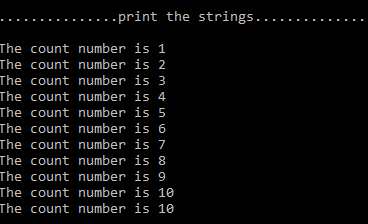C语言 fprintf 函数 – C语言零基础入门教程
目录
- 一.fprintf 函数简介
- 二.fprintf 函数使用
- 三.猜你喜欢
零基础 C/C++ 学习路线推荐 : C/C++ 学习目录 >> C 语言基础入门
一.fprintf 函数简介
fprintf 是 C / C++ 中的一个格式化库函数,位于头文件 中,其作用是格式化输出到一个流文件中;函数原型为
/*
*描述:fputs 函数是向指定的文件写入一个字符串
*
*参数:
* [in] stream: 文件指针句柄;
* [in] format: 格式化字符串,与 printf 函数一样;
*
*返回值:如果成功,该函数返回一个非负值,如果发生错误则返回 EOF(-1)。
*/
int fprintf (FILE* stream, const char*format, [argument]);
fprintf 函数是变参函数,format 可以由一个或者多个参数构成,案例如下:
//示例:
fprintf(stream,"www.codersrc.com
");
fprintf(stream,"www.codersrc.com age:%d
",17);
fprintf(stream,"www.codersrc.com age:%d name:%s
",17, "zhangsan");
fprintf(stream,"www.codersrc.com age:%d name:%s height:%f
",17, "zhangsan",1.75);
二.fprintf 函数使用
/******************************************************************************************/
//@Author:猿说编程
//@Blog(个人博客地址): www.codersrc.com
//@File:C语言教程 - C语言 fprintf 函数
//@Time:2021/07/30 07:30
//@Motto:不积跬步无以至千里,不积小流无以成江海,程序人生的精彩需要坚持不懈地积累!
/******************************************************************************************/
#include <cstdio>
#include<stdio.h>
#include<stdlib.h>
int main()
{
//Initialize the file pointer
FILE *f;
char ch[100];
// open the file for read and write operation
if((f=fopen("test.txt","r+"))==NULL){
//if the file does not exist print the string
printf("Cannot open the file...");
exit(1);
}
for(int i=0;i<10;i++){
//enter the strings with values in the file
fprintf(f,"The count number is %d
",i+1);
}
fclose(f);
// open the file for read and write operation
if((f=fopen("test.txt","r+"))==NULL){
//if the file does not exist print the string
printf("Cannot open the file...");
exit(1);
}
printf("File content is--
");
printf("
...............print the strings..............
");
while(!feof(f)){
//takes the first 100 character in the character array
fgets(ch,100,f);
//and print the strings
printf("%s",ch);
}
//close the file
fclose(f);
return 0;
}
通过 fprintf 函数将数据写入到文件中,在通过 fgets 函数读取文件的每一行数据;

三.猜你喜欢
- C 语言 数组下标越界和内存溢出区别
- C 语言 使用指针遍历数组
- C 语言 指针和数组区别
- C 语言 指针数组和数组指针区别
- C 语言 野指针
- C 语言 函数值传递和址传递
- C 语言 函数不定长参数
- C 语言 函数指针
- C 语言 指针函数
- C 语言 回调函数 callback
- C 语言 #pragma once
- C 语言 #include <> 与 #include “” 区别
- C 语言 const 修饰函数参数
- C 语言 const 和 define 区别
- C 语言 #运算符
- C 语言 ##运算符
- C 语言 __VA_ARGS__
- C 语言 ##__VA_ARGS__
- C 语言 函数不定长参数 ##__VA_ARGS__经典案例
- C 语言 va_start / va_end / va_arg 自定义 printf 函数
- C 语言 main 函数
- C 语言 main 函数参数 main(int argc, char *argv[])
- C 语言 局部变量
- C 语言 全局变量
- C 语言 全局变量和局部变量区别
- C 语言 static
- C 语言 extern
未经允许不得转载:猿说编程 » C 语言 fprintf 函数
本文由博客 – 猿说编程 猿说编程 发布!


